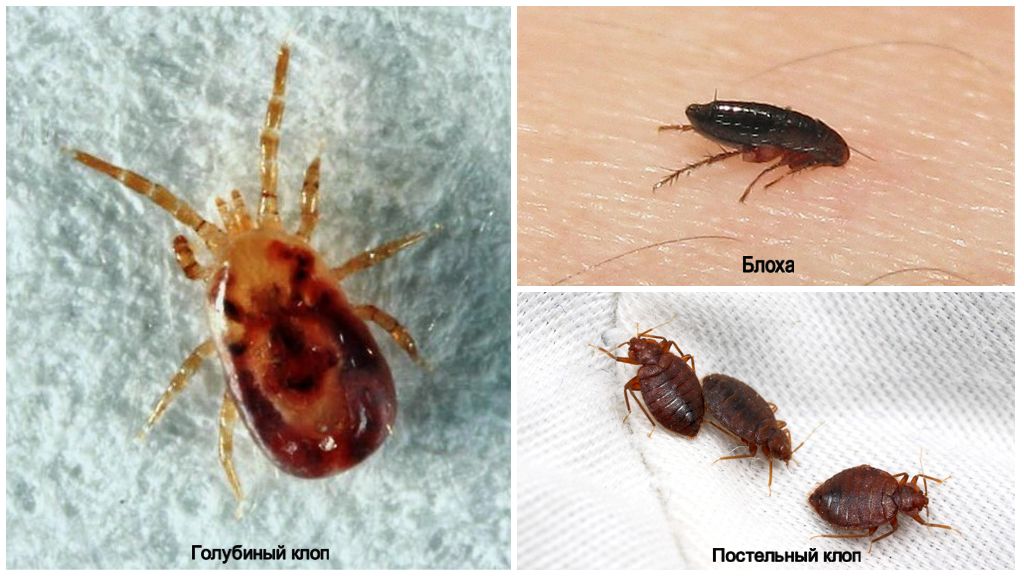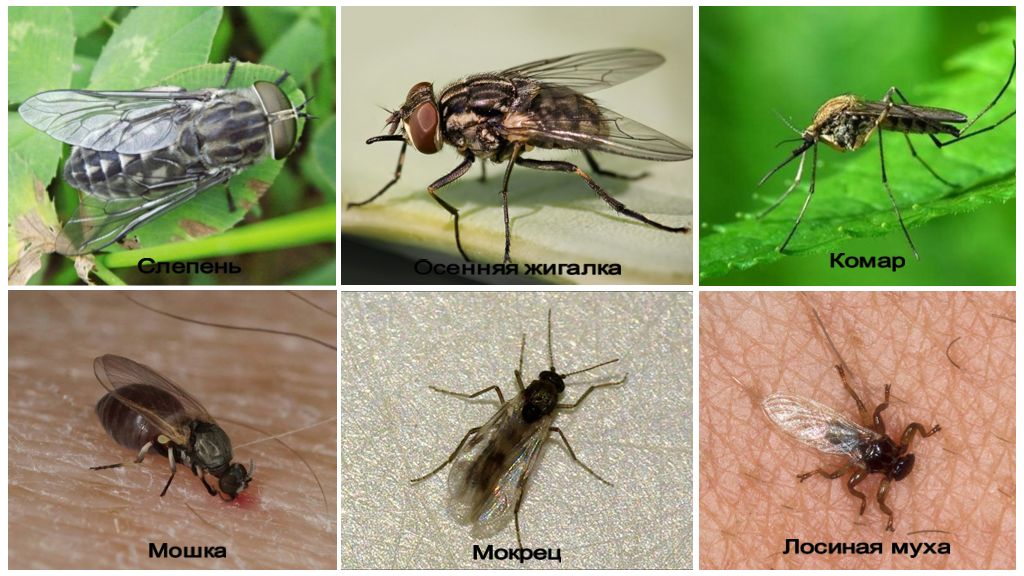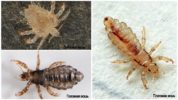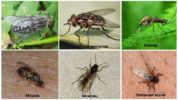- Blood sucking insects
- Blood sucking insects
- Blood sucking insects
Sincerely believing themselves to be higher beings, people still have not been able to get rid of a small but serious problem. Blood-sucking insects, which spoiled humanity's life several million years ago, continue to be spoiled today. Even far from nature in megacities are those who want to get drunk on human blood. Some bloodsuckers left the caves in order not to part with their favorite dish and turned into synanthropic species. They now breed not in caves, but in the basements of houses and apartments.
Synanthropic bloodsuckers
The bulk of synanthropic species refers to temporary blood-sucking parasites. This group is highly mobile and spends most of its life in the external environment. They are harassed by lice, fleas and bugs in houses.
Fleas
Small black insects with a flat body, capable of jumping. Flea length 1-3 mm. In Russia, you can find 5 species of these blood-sucking insects:
Flea species morphologically very slightly differ from each other. They feed on the blood of any turned up mammal.
On a note!
Fleas belong to temporary bloodsuckers, since they only jump on a victim to drink blood. Of the entire population of insects living in the apartment, only 10% is on the victim.
Parasites prefer to breed in moist, damp places, that is, in basements or bathrooms. In an extreme case, they will cost a click behind the baseboard, clogged with house dust.
Under natural conditions, fleas are active around the clock in the warm season. In homes, they breed year-round. The usual adult lifespan is 2 months.
On a note!
Fleas can carry a significant number of infectious diseases.
Bed bugs
Synanthropic bloodsuckers. A person is attacked by bed and pigeon bugs.

Bed
A wingless blood-sucking insect is a parasitic companion of man. Bed bugs drink blood from people with little interest in other objects. The neighborhood of bugs can be seen only by bite marks on the bodysince insects are active at night. Due to the fact that the bug spends most of the time outside the host in the shelter, it is also a temporary blood-sucking insect.
On a note!
The body of the bug is painted brown. The insect is flattened from above. Such a structure allows a hungry bug not to fear for his life. Eating insects are much more vulnerable, and a person can even accidentally crush them.
Bedbugs are “suspected” of transmitting blood-borne diseases. For example, hepatitis B.
Pigeon
Insects sucking the blood of pigeons, chickens and other birds. The appearance and lifestyle of pigeon / bird and bed bugs are similar. Both are active at night, breed in secluded places outside the host and drink blood. But the pigeon usually lives in bird nests and does not touch a person. Until the birds leave their home. Left without a host, a starving parasite creeps into an apartment and attacks a person. This is the danger of bird bugs: they transmit from birds many dangerous diseases to which humans are exposed. These diseases include ornithosis.
Lice
Lice - Permanent human parasites.These are small blood-sucking insects that spend their whole life on the host. By laying an egg, a louse sticks it to a person’s hair. There are 3 types of human lice:
On a note!
Scientists believe that the head and the clothes are related species that have recently separated by the standards of evolution.
These two types of insects are very similar morphologically:
- long narrow body;
- elongated abdomen;
- the head is smaller than the cephalothorax;
- gray color of a hungry insect.
But the spheres of their habitation are different: the head lives only in the hair, clothes - in the folds of clothes.

Pubic differs from the two previous species in body shape. She is "round." The body of the pubic louse is very short. Expands to the front end and tapers to the rear. The shape of the body is more like a crab, a forest bug. Her habitat:
- groin area;
- axillary hollows;
- eyebrows;
- eyelashes.
In other areas of the human body, pubic louse does not occur if it does not accidentally get there.
Gnus
In addition to the synanthropes, there were bloodsuckers who did not leave their natural habitat, although some of them can live in the city. Most of these insects are united by the concept of “vulture”. The set of blood-sucking flying organisms is “gnats” - insects with two wings of different sizes, combined only by the need to drink blood for breeding. The totality of the vile includes:
- horseflies;
- autumn lighter;
- mosquitoes;
- midges;
- biting midges;
- mosquitoes;
- tsetse flies.
The very concept of “heinous” came from Siberia, where small bloodsucking insects were called by this word.
On a note!
Due to the vileness in the taiga, people are forced to wear masks. But it doesn’t save much. Cats find cracks and clog even under clothes.
Gadgets
The largest flying bloodsucking insects in Russia. These are flies that require blood to drink to breed. Dwell horseflies in forest, steppe and desert zones. Most species are kept near water bodies, since the development of larvae takes place in a humid environment. Only females drink blood. In addition to soreness horsefly bite, insects are dangerous because they carry infectious diseases. Actively given family of bloodsuckers in the daytime. Prefer the heat. In the early morning and twilight, they do not bother animals.
Autumn Lighter
Small fly, very similar to a brownie. Often these two species are confused. But the brownie does not belong to bloodsucking. Distinctive feature autumn lighter in that it is an insect that drinks blood differently from other bloodsuckers. The lighter does not pierce the skin, but scrapes off the top layer and licks out the protruding liquid. In parallel, it releases toxic saliva, which dilutes blood.

On a note!
Lighters are active during the day during the entire warm season. At the beginning of summer they are not noticed, since the number of these bloodsucking flies is still insignificant. In the fall, before hibernation, a multiplying population gives people a lot of inconvenience.
Mosquito
The most famous insect is a bloodsucker. Even city dwellers are familiar with it, since often these blood-sucking dipterans breed directly in the basements of houses. Species of mosquitoes a lot, some of them are completely harmless. Of the blood-sucking mosquitoes, females are parasitizing. Without a portion of blood, the mosquito cannot lay eggs. Active mosquito hunting falls at night.
Midge
Small two-winged insects included in the totality of “vile”. Moshka lives on all continents. Females are blood-sucking, males feed on nectar. Leave stronger swelling than mosquitoes. The cat does not pierce the skin, but cuts it. Injects saliva with anticoagulants into the wound. Insects are active in calm weather at a temperature of 8-30 ° C. In windy weather it blows them away. Cats carry many diseases that are dangerous to humans.
Bells
Very small bloodsucker insects that look like mosquitoes. They live everywhere except Antarctica. Mokrets - the name of the family, not the species.There are genera in the family that feed only on nectar or are predators. There are also births where females are blood-sucking and males are “vegetarians”. Females from blood-sucking species are included in the totality of “heinous”. Insects are capable of transmitting infectious diseases.
On a note!
The tsetse fly does not live in Russia, but mosquitoes come across only in warm regions. Like other blood-sucking parasites, mosquitoes are capable of transmitting infectious diseases.
Moose fly
Insect of the bloodsucker family. The second name is deer bloodsucker, in everyday life are often called bugs bloodsuckers. The species is very numerous in Russia in both the European and Asian parts. Having found the owner, the insect drops its wings and remains to live on the animal. Due to the lack of wings, bloodsuckers are often confused with ticks. Flies are similar to these arthropods not only in body color, but also in the tenacity of their legs.
There are 778 species in the family and all of them are blood-sucking parasites.
Bloodsuckers rarely attack a person, but such cases occur. Bloodsucker and horsefly bites are comparable in pain.






